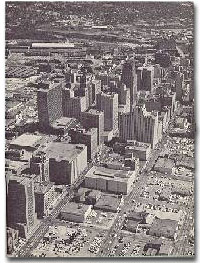OUR LEGACY - Boomtown
 The city's development from a small backwater settlement into a prosperous metropolis of international significance took place within the relatively short period of 175 years. Its economic history helps explain why Houston is the city of destiny.
The city's development from a small backwater settlement into a prosperous metropolis of international significance took place within the relatively short period of 175 years. Its economic history helps explain why Houston is the city of destiny.
It has been said that Houston is a flourishing trade center today because of its fortunate location. John and Augustus Allen, the enterprising pioneers, chose this spot in 1836 because it was the navigation point closest to the already established settlement of San Felipe de Austin on the Brazos, which Stephen F. Austin had established as the first Anglo-American community in Texas. Most of Houston's original settlers came on small boats up the bayou, which connected the city with Galveston Bay and the Gulf of Mexico. The first steamship, the 85-foot long Laura M. sailed up Buffalo Bayou in January of 1837, demonstrating that the city could indeed develop into an inland port.
Houston's first economic crisis came three years after its founding, when New Orleans' suppliers cut off Houston merchants' credit, and the Republic of Texas currency dropped to one-quarter and then to one-tenth the value of the U.S. dollar. Simultaneously, the capital was moved from Houston to Austin, another threat to the city's economic stability. As if these set backs were not enough, an epidemic of yellow fever swept through the city, wiping out one tenth of the population.
Despite these problems, Houston slowly began to recover during the 1840's, emerging as the commercial center for nearby towns. Important to Houston's future economic development was the treaty by which the Republic of Texas became, in 1846, a part of the United States. This made Houston more accessible to the flow of capital and people. Houston built warehouses and stored cotton during the 1850's as its brokers continue to do today. The city established, in addition, a strong agricultural and lumber trade. Houston's first rail link was laid in 1853, a turning point in the city's development as a national marketing center.
The War between the states had an adverse effect on Houston's economy. The war effort and the consequent dislocation of people disrupted the city's economy. As a result, the postwar Reconstruction period brought economic hardships to Texas. But the financial losses suffered during the war and its aftermath subsided sufficiently to allow Houston's economy to grow again.
Major products were cotton, lumber and cattle. The Port of Houston served to aid and diversify the lumber industry, since pine and hardwood were transported by way of the ship channel. As the amount of marine traffic to the East Coast increased, the channel was expanded to an average 12 foot depth by Commander Charles Morgan, who obtained a federal grant for the project. Morgan later stretched a chain across the channel at Morgan's Point and charged all comers a toll. Following Morgan's death in 1892, the United States government paid his heirs $92,888 for the rights to the channel and the toll restriction was removed. Eventually, the channel was deepened to 17.5 feet.
Until the turn of the century, Houston's economy was largely based on agriculture and ranching. Besides cotton, cattle and timber, rice growing and fishing gained significance. All, however, were overshadowed when oil was discovered at Spindletop in 1901. The development of this potent natural resource then became the most significant layer of Houston's economy. "Houston" and "Texas" became synonymous with "oil." As oil revolutionized social structures and priorities at home and abroad, it served to propel the United States toward economic and political leadership in the world.
Two major events contributed to Houston's economic advancement. On September eighth and ninth, 1900, a tidal wave and hurricane struck Galveston Island. Thousands lost their lives and hardly a building on the entire island remained standing. The aftermath of this disaster served to revitalize efforts to set up Houston as a major port. Unlike Galveston, the Port of Houston is located inland and is largely immune to such disasters. Congress then invested more money in waterway improvements. The Texas legislature established the Harris County-Houston Ship Channel Navigation District, today called the Port of Houston Authority, and in November 1914, President Woodrow Wilson pushed the button in Washington, D.C., which fired a cannon in Houston and officially opened the then 25-foot deep ship channel. The Port of Houston became increasingly a major factor in the city's economic development.
The other event that worked in Houston's favor was when the United States turned to Houston for the oil and fuel needed for the World War I effort. By this time, Houston had an expanded port facility capable of handling vital overseas shipments. The first deep water vessel, in fact, arrived at the Port of Houston in August, 1915, and the first refinery was set up along the ship channel in 1918. The growth of the automobile industry-- the largest manufacturing industry of all time---lead to increased demands for oil. The oil industry expanded its incredible production capacity to fill the automobile's insatiable maw.
The 1920's were, for Houston, an era of prosperity. The port and railroads expanded, cotton revenues reached new heights, and new construction altered the city's skyline. However, the Great Depression, beginning in October 1929, tried Houston's economic strength. Although business activities declined throughout the nation, Houston's economy was relatively stable, and not one bank failed. Industry became an important part of the economy in the 1930's, although agriculture and oil remained the leading sectors in the city's successful economy.
The 1940's brought greater diversification. The continued growth of the oil industry induced major process industries to locate along the banks of the ship channel. Cement plants, a paper mill and a steel plant flourished in the area, and a third important layer was added to Houston's complex economy. World War II pushed the Port of Houston to ever greater expansion. The city became the center of the explosive development in the petrochemical industry, which used oil products to manufacture such vital materials as synthetic rubber. The industry continued to expand and went on to include plastics, besides oil tools and equipment. Food processing (coffee and rice) and high-technology industries added another dimension to Houston's economy during this period.
In the post-war period the Texas Medical Center became a reality, elevating Houston to international prominence in the field of medicine. The National Aeronautics and Space Administration chose Houston for its Manned Spacecraft Center, and the center was completed in the late 1960's. Houston became known as "Space City," as the world looks through its eyes between science and practicality, became a more significant activity in and around the city.
The 1960's saw a dramatic increase of construction and the establishment of divisional and service headquarters by some of the nation's largest corporations in Houston.
Houston today is not only the oil capital of America but it is also the world's energy capital, with leaders in research and development shaping its future.
As the city's economy continued to diversify, it became increasingly more international. Foreign trade grew to almost one-half of the Port of Houston's total tonnage by the 1970's.
The city has incorporated an impressive series of economic activities into a multifaceted and thriving economy. It is true that Houston has had outstanding opportunities for economic enlargement but another vital factor in the success of the Houston economy is its business climate.






